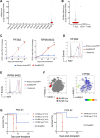A functional role of Ephrin type-B receptor 6 (EPHB6) in T-cell acute lymphoblastic leukemia
- PMID: 37858274
- PMCID: PMC10588013
- DOI: 10.1186/s40364-023-00531-3
A functional role of Ephrin type-B receptor 6 (EPHB6) in T-cell acute lymphoblastic leukemia
Abstract
T-cell lymphoblastic acute leukemia (T-ALL) is an aggressive blood cancer, characterized by restricted cellular subsets with enriched leukemia initiating cells (LICs). Recently, Ephrin receptors (Eph) were described to be highly expressed in cancer stem cells. Here, using public RNA-Seq datasets of human T-ALL, we reported that EphB6 was the only member within the Eph family overexpressed in over 260 samples. We also found the highest level of EphB6 in a minor cell subpopulation within bulk tumors of patient-derived xenografts, obtained through the injection of primary patient biopsy material into immunocompromised NOD-Scid/IL2Rγc-/- (NSG) mice. Interestingly, this EphB6 positive (EphB6+) subset showed an enriched LIC activity after in vivo transplantation into NSG mice. Additionally, gene expression data at the single-cell level of primary patients' leukemic cells revealed that EphB6 + cells were significantly selected in minimal residual disease up to 30 days from the standard treatments and characterized by high levels of markers related to cell proliferation and poor clinical outcome, such as CCNB1 and KIF20A. Taken together, our data suggest that EphB6 supports LICs' maintenance and progression in T-ALL and, thus, targeting EphB6 + cells could be therapeutically relevant for the treatment of T-ALL patients.
Keywords: Biomarkers; EphB6; Leukemia-initiating cells (LICs); Single-cell RNA-Sequencing; T-ALL.
© 2023. Yumed Inc. and BioMed Central Ltd., part of Springer Nature.
Conflict of interest statement
Alberto Visioli is an employee of Stemgen Spa and does not own shares in the Company. The others authors declare that they have no competing interests.
Figures


References
-
- El Zawily A, McEwen E, Toosi B, Vizeacoumar FS, Freywald T, Vizeacoumar FJ, Freywald A. The EphB6 receptor is overexpressed in pediatric T cell acute lymphoblastic leukemia and increases its sensitivity to doxorubicin treatment. Sci Rep. 2017;7(1):14767. doi: 10.1038/s41598-017-15200-3. - DOI - PMC - PubMed
-
- Committee EN. Unified nomenclature for eph family receptors and their ligands, the ephrins. Eph Nomenclature Committee Cell. 1997;90(3):403–4. - PubMed
Publication types
Grants and funding
LinkOut - more resources
Full Text Sources
Miscellaneous

